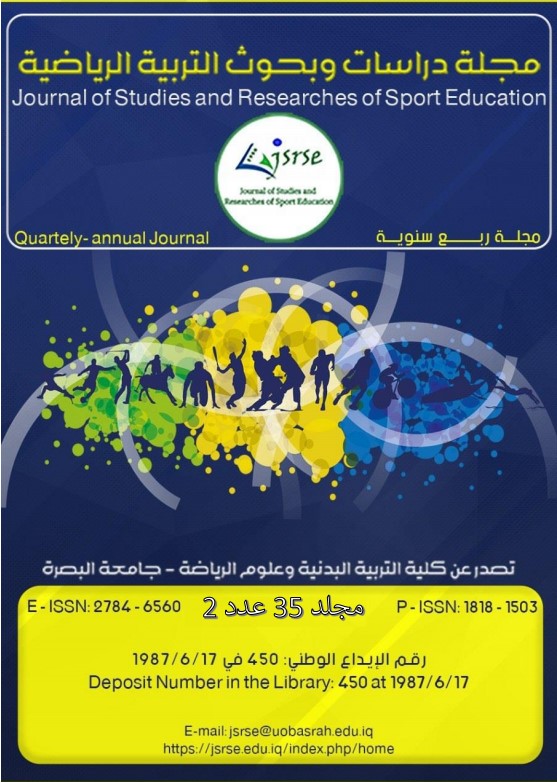Building a female model for the weight path in the snatch lift for the Egyptian world champion weightlifter Sarah Samir
Main Article Content
Abstract
The research aimed to identify the analysis of the variables related to the weight path, and the researcher used the descriptive approach in the style of survey studies, in which the researcher is interested in observing the phenomenon and collecting information about it in the current state. The research sample was the Egyptian international weightlifter (Sarah Samir) - junior category, as a side-view clip of the stages of the snatch lift was obtained through interviews and correspondence on social media. The variables were analyzed using the Kinovea program, and the researcher concluded that the weightlifter enjoys high technical performance, reflecting the application of mechanical characteristics and principles. The researcher also recommends the necessity of taking the results of this research and benefiting from them during the stages of learning and training.
Article Details

This work is licensed under a Creative Commons Attribution-NonCommercial 4.0 International License.
References
Aldiwan, L. H., Abdul, J. A. Z. K. J., & Canaan, Z. (2013). Find extract Impact multimedia system integrated collaborative learning style in the education of the technical performance of the elevation jerk and the cognitive level of weightlifting. Journal of Studies and Researches of Sport Education, 35.
Al-Dulaimi, S., & Moatasem, M. (2010). An analytical study of the mechanical capacity of the weight for failed and successful attempts in the snatch lift. Al-Rafidain Journal of Sports Sciences, 16(55).
Al-Fadhli, S. A. K., & Al-Majdi, A. R. J. (2017). Functional Anatomical Analysis and Mechanics of Sports Games. Adnan House for Printing, Publishing and Distribution, Baghdad.
Al-Fadhli, S. A. K., & Ihab, D. H. (2019). Applied Kinesiology. Al-Faisal Library for Printing and Publishing.
Al-Saeed, R., & Pain, M. T. G. (2017). Descriptive analysis of hip and knee joint loading during reverse roundhouse kick (hook) karate kick performed in training and competition modes. ISBS Proceedings Archive, 35(1), 9.
Alwan, H. F., Kazem, H. A. R., & Fadel, M. J. (2019). The effect of ballistic training using weights in developing some physical abilities specific to the achievement of weightlifters, snatch and clean and jerk. Journal of Sports Education Studies and Research, 29(3), 72–80.
Falih, A. N. (2016). Evaluation of the weight path in the snatch lift for the Iraqi national team weightlifters. Journal of Physical Education, 28(4.2), 109–128.
Farhan, S. A. N. P. D. (2021). Constructing a model of artistic performanceBiokinematics The hero Iraqi Asian weight lifter 85 (Safaa Rashid Al-Jumaili) in the snatch. Journal of Studies and Researches of Sport Education, 67.
Haider, A. R. (2015). Basics of writing scientific research in physical education and sports sciences (1st edition, p. 128). Al-Ghadeer Printing and Publishing Company Limited.
I.W.F. (1998). International weightlifting federation: Technical rules, anti-doping policy directory (2nd edition). Budapest , Belgium .
Khaled, A. M. A. A. et al. (2020). Principles of Kinesiology. Assiut University.
Mashkoor, N. H. (2010). The relationship between the angle of departure from the starting support and the time of abandonment and the average speed of the first stage (speed increase). Journal of Studies and Researches of Sport Education, 27. https://www.iasj.net/iasj/article/53710
Nasser, S. A., Muhi, M. A., & Karim, S. M. (2021). The relationship between the angular velocity of the knee and hip joints and the weight deviations in the first pulling phase with the weight deviation values in the snatch lift. Journal of Sports Education Studies and Research, 31(2), 10–20. https://www.jsrse.edu.iq/index.php/home/article/view/44
Shalash, N. M., & Mazen, A. H. A. (2005). Principles of Motor Learning (2nd ed). Dar Al Diaa for Printing and Design.





 IASJ
IASJ CC-BY-4.0
CC-BY-4.0 turnitin
turnitin ISSN
ISSN DOAJ
DOAJ Crossref
Crossref GoogleScholar
GoogleScholar Orcid
Orcid